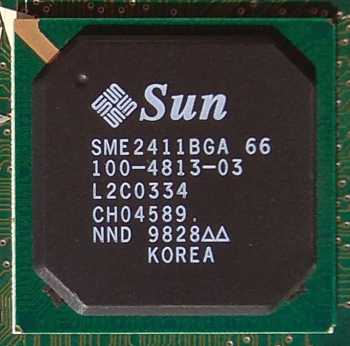SME2411 APB
The Advanced PCI Bridge (APBTM), SME2411, is a PCI-to-PCI bridge chip that is compatible with version 2.1 of the PCI Local Bus Specification [1]. The APB features a connection path between a 32-bit bus running at speeds up to 66 MHz on the primary interface and two 32-bit, 5 V or 3.3 V, PCI buses (each running up to 33 MHz), on the secondary interface. It is primarily intended as an interconnect mechanism, for use in an UltraSPARC-IIi-based system.
The APB provides the UltraSPARC-IIi microprocessor direct access, with minimum latency, to devices located on a connected PCI bus and mapped in the processor’s I/O or memory address space. In addition, it provides PCI masters direct, high-capacity access to main memory. Use of the APB depends upon the organization of the PCI bus.
Features
- 32-Bit PCI Revision 2.1 Compatible [1]
- PCI Bridge Specification 1.0 Compatible [1]
- 32-Bit Memory Addressing for PIO and DMA
- 64-Bit Memory Addressing (DACs) for DMA
- 24-Bit I/O Addressing (PIO only)
- Full Concurrency for Primary and Secondary PCI Interfaces
- Uses Deadlock Detection / Recovery Mechanism
- Data Buffering
- A 72-Byte Buffer (FIFO) on each of the DMA and PIO Paths
- Two On-Chip Programmable Arbiters
- One for each Secondary PCI Interface
- Each One Handles up to 4 Secondary Bus Masters
- Priority to each Master is Programmable, so any Master can be Given Priority
- External Arbiters for Secondary PCI Buses Allowed
- Retry Counters and Latency Timers can be Configured for Differing Performance Requirements
- Prefetching for some Memory Read Commands
- Prefetching Algorithm can be Varied for DMA
- Interrupt Handling
- Synchronization Mechanism for DMA Writes
- PCI Interrupts are Routed through an External Interrupt Concentrator
- PCI Optional Features Implemented [2]
- Fast Back-to-Back Capable as a Target
- Medium Decode Timing
- Boot Mode Allows APB to Be Used in the Path of the Boot PROM
- Transactions Originating on One Secondary Bus Cannot Be Destined for Targets on the Other
- Little-Endian to the Bus and Internal Configuration Space
- Errors Resulting in Assertion of SERR# Are Logged
- PIO Reads and Writes are in Non-Cacheable Memory Space (When Used with UltraSPARC-IIi)
Disclaimer
The info found in this page might not be entirely correct. Check out this guide to learn how you can improve it.
 Image 1 of 1 (Rigo "0xCats" Reddig)
Image 1 of 1 (Rigo "0xCats" Reddig)